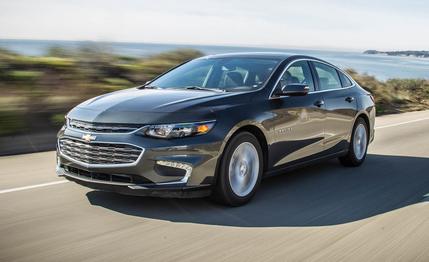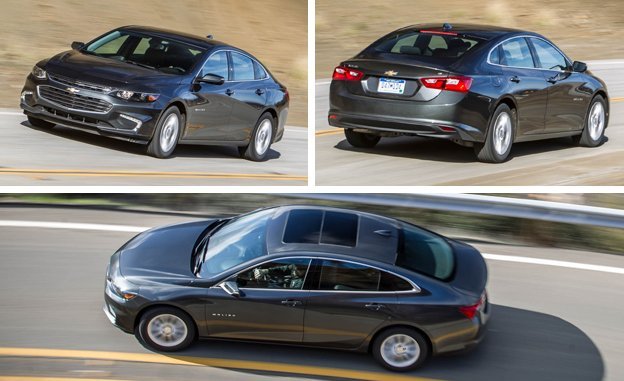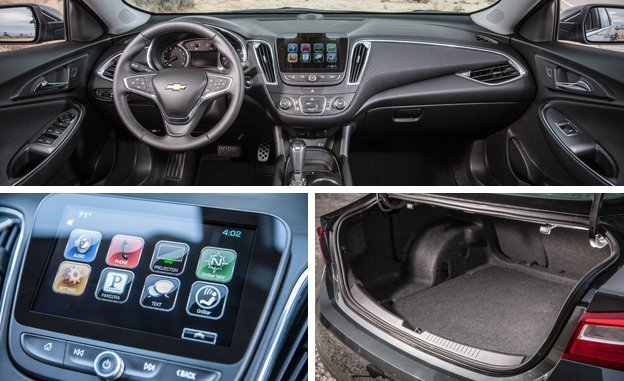
 Instrumented Test
Instrumented Test
When Chevy brought back the Malibu nameplate for 1997, the resultant automobile carried the treacly tagline “The car you knew America could build,” as if to finally admit that the preceding two decades of Chevrolet automobiles had largely been misbegotten junk. That car still lacked the style and quality of the Japanese offerings of the era, and its inoffensive blandness was less progressive than the styling of its Oldsmobile Alero platform-mate. While GM rallied in the direction of goodness with the 2008–2012 models, that car’s follow-up felt like a regression. We’ve already gone on record saying that the attractive new ’Bu “feels like a quality car, not at all like its many banged-together and shoved-out predecessors,” but we also lambasted its 2.0-liter turbocharged four-cylinder engine for delivering “V-6 fuel economy with not-quite–V-6 acceleration.” Might a less-expensive, less-powerful version fare better?
We’d say yes. The turbocharged 1.5-liter Malibu makes do with 87 fewer horsepower and two fewer gear ratios when compared with the top-rank powertrain, but our test example weighed in at a svelte 3159 pounds—148 fewer than the Premier-spec 2.0-liter car we tested. While it gave up 0.1 g on the skidpad to its more expensive sibling, we feel the blown 1.5 offers a more nimble feel on the road than the heavier 2.0 turbo.


While the 1.5 isn’t nearly as powerful as the 2.0, its 163 horses are delivered with significantly more smoothness. In fact, this may well be GM’s best four-banger. Its 184 lb-ft of torque are wholly available between 2000 and 4000 rpm, making it well-suited to the cut and thrust of urban and suburban traffic, while lag at the bottom of the rev range is minimal. Needing 8.0 seconds to reach 60 mph, this is not a particularly quick car. Yet, the lesser ’Bu can hold its own against the 2.5-liter Toyota Camry, and our observed 23 mpg is comparable to many of the four-cylinders in the sprawling family-sedan class.
General Motors has focused heavily on ride quality in recent years, and sometimes the emphasis feels single-minded, as if billiard-table smoothness in the cabin will atone for any number of dynamic sins. This impression has been on the wane of late, and the Malibu retains the excellent ride of its predecessors, while throwing in a modicum of dynamic refinement to sweeten the pot. In corners, body motions are controlled and predictable, although the rear end does have a tendency to step out under trail-braking. One change that would make a world of difference: Trade the numb-plus-numb Goodyear Assurance tires for a set of mildly more aggressive rubber. During a downpour in the Santa Monica Mountains, we weren’t always sure how long the front end was going to stay planted. Dry conditions erased the spookiness, offering progressive, early understeer. This chassis is good enough to handle more grip. The steering is direct, even as it lacks the telepathic link offered by Honda’s Accord or the sporty feel of the Mazda 6.
Nobody has purchased a new Malibu with sporting intent since the 454 V-8 ceased to be an available option. The fact that the new car is good in more than a straight line merely comes as a pleasant addendum to the comfort-focused package. To that end, GM has lavished upon it the 4G LTE connectivity that everybody can’t seem to get enough of these days, and a 7.0-inch touchscreen runs reliable, relatively intuitive MyLink infotainment with Apple CarPlay. Back-seat passengers get an assortment of plug-in options, including USB, 12-volt, and a genuine household electrical socket. Up front, 12-volt and USB sockets reside up and under the center of the dash, helpfully marked by ungainly screenprinting on the console below.


Materials-wise, the cabin fares well—it’s at least as good as most other automobiles in the segment, and it’s only clearly outdone by the Mazda 6 and the Volkswagen Passat. The dash fabric, featuring a sort of chainlink-fence pattern, garnered mixed reviews from our staff. While some appreciated the rather bold choice, others found it a mite weird. Regardless, fit and finish are very good, and the upholstery’s stitching is a cut above that in the Accord and the Camry, the segment’s perennial stalwarts.
The interior suffers only a few major bugaboos. From a driver’s standpoint, the sequoia-thick, steeply raked A-pillars tend to obscure vision in corners. And the dinky toggle atop the shifter for manual gear selection is so ineffective that Chevrolet shouldn’t have even bothered. From a passenger’s perspective, the rear seat is rather narrow for three average adults, though even tall center occupants should find themselves with plenty of headroom.
With a $25,895 base price, the Malibu LT represents a solid value in the class. It only truly excels at offering a plush ride and thoughtful sops to internet connectivity, but Chevy’s new mid-sizer does enough other things well to make it a wholly competitive entry in the family-sedan segment—one that shouldn’t require a hokey, hopeful tagline to lure buyers into showrooms.